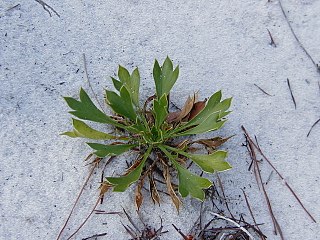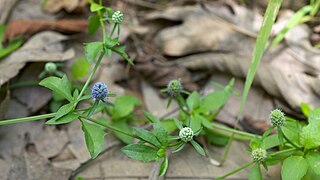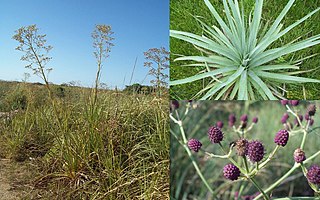
Eryngium is a genus of flowering plants in the family Apiaceae. There are about 250 species. The genus has a cosmopolitan distribution, with the center of diversity in South America. Common names include eryngo and sea holly.

Eryngium alpinum, the alpine sea holly, alpine eryngo or queen of the Alps, is a herbaceous perennial plant in the family Apiaceae.
Hinton Charterhouse Field is a 0.32 hectare biological Site of Special Scientific Interest (SSSI) near the village of Hinton Charterhouse in Bath and North East Somerset, United Kingdom. It was SSSI notified in 1991.

Eryngium amethystinum, the amethyst eryngo, Italian eryngo or amethyst sea holly, is a clump-forming, perennial, tap-rooted herb. Its stem is 30 to 50 cm long and is light blue to purple in colour. It has a basal circle of obovate, pinnate, spiny, leathery, mid-green leaves. It flowers in mid to late summer with cylindrical umbels, 2–3 cm long atop silvery blue bracts and branching stems. The plant is native to the eastern Mediterranean and prefers dry places and soils that are rich in calcium.
The Office of Kentucky Nature Preserves is an agency of the Commonwealth of Kentucky in the United States dedicated to the protection of Kentucky's natural heritage. The agency's primary focus is protecting rare and endangered species habitat. It oversees a statewide program of nature preserves, the Kentucky Wild Rivers Program, and the "Nature's Finest" license plate program of the Kentucky Heritage Land Conservation Fund Board. The program was formerly known as the "Kentucky State Nature Preserves Commission", from 1976 until a reorganization in 2018.
Great Valley Grasslands State Park is a state park of California, United States, preserving a parcel of remnant native grassland in the San Joaquin Valley. Such a temperate grasslands, savannas, and shrublands biome was once widespread throughout the whole Central Valley. The 2,826-acre (1,144 ha) park was established in 1982. Largely undeveloped, it was formed by combining two former state park units: San Luis Island and Fremont Ford State Recreation Area. Its chief attractions for visitors are spring wildflowers, fishing, and wildlife watching.

Eryngium aristulatum, known by the common names California eryngo and Jepson's button celery, is a species of flowering plant in the family Apiaceae.
Eryngium constancei is a species of flowering plant in the family Apiaceae known by the common name Loch Lomond button celery, or Loch Lomond coyote thistle. It is endemic to California, where it is known from only three occurrences north of the San Francisco Bay Area. One of the populations is at the Loch Lomond Vernal Pool Ecological Reserve at Loch Lomond in Lake County. The plant appears mainly in vernal pools. It is endangered on the state and federal levels.
Eryngium pinnatisectum is an uncommon species of flowering plant in the family Apiaceae, known by the common names Tuolumne eryngo and Tuolumne button celery.
Eryngium racemosum is a rare species of flowering plant in the family Apiaceae known by the common name delta eryngo, or delta button celery.
Eryngium spinosepalum, known by the common names spinysepal eryngo and spiny-sepaled button celery, is an uncommon species of flowering plant in the family Apiaceae.

Eryngium cuneifolium is a rare species of flowering plant in the carrot family known by the common names wedgeleaf eryngo, wedge-leaved button-snakeroot, and simply snakeroot. It is endemic to the state of Florida in the United States where it is known only from Highlands County. It is one of many rare species that can be found only on the Lake Wales Ridge, an area of high endemism. It was federally listed as an endangered species of the United States in 1987.

Eryngium planum, the blue eryngo or flat sea holly, is a species of flowering plant in the family Apiaceae, native to the area that includes central and southeastern Europe and central Asia. It is an herbaceous perennial thistle growing to 50 cm (20 in) with branched silvery-blue stems, and numerous small blue conical flowerheads surrounded by spiky bracts in summer.

Parnassia caroliniana is a species of flowering plant in the Celastraceae known by the common name Carolina grass of Parnassus. It is native to the southeastern United States, where it occurs in North Carolina and South Carolina, with an isolated population in the Florida Panhandle.

Eryngium aquaticum is a species of flowering plant in the family Apiaceae known by the common name rattlesnakemaster, marsh rattlesnake master, corn-snakeroot, bitter snakeroot, and marsh eryngo. This plant is native to eastern North America.

Eryngium prostratum, commonly called creeping eryngo, is a species of plant in the family Apiaceae that is native to the southeastern United States.

Eryngium creticum, or the field eryngo, is a species of flowering plant in the family Apiaceae native to Greece, Israel, Jordan, Lebanon, Palestine, and Syria. It is known in Lebanon and Palestine as قرصعنة and in Israel as חרחבינה מכחילה.

Eryngium pandanifolium, called the pandan-like-leaved eryngo, is a species of flowering plant in the genus Eryngium, native to Brazil, Paraguay, Uruguay, and Argentina, and introduced in Australia, New Zealand and Portugal. It has gained the Royal Horticultural Society's Award of Garden Merit.
Eryngium baldwinii is a biennial aromatic herb in the Eryngium genus. Its common name is Baldwin's eryngo. It can grow to become a spread out groundcover with hazy appearing light blue flowers. It is named for Willliam Baldwin.

Kankakee Sands is a 10,000-acre (4,000 ha) restored tallgrass prairie in Kankakee County, Illinois and Newton County, Indiana. It is managed by The Nature Conservancy staff and volunteers. The Efroymson Restoration at Kankakee Sands is 8,400 acres (3,400 ha) of prairies and wetlands connecting Willow Slough Fish and Wildlife Area, Beaver Lake Nature Preserve, Conrad Savanna Nature Preserve and Conrad Station Savanna. This creates over 20,000 acres (8,100 ha) of dry, mesic and wet sand prairies, sand blows, sedge meadows, wetlands, and black oak savannas.












